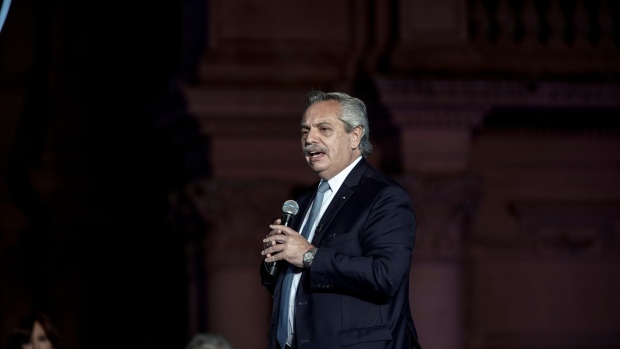Sep 1, 2022
Argentina’s YPF Signs LNG Export Feasibility Study With Petronas
, Bloomberg News

(Bloomberg) -- Argentina is taking preliminary steps to tap its potential for exporting liquefied natural gas, President Alberto Fernandez announced Thursday.
YPF, the state-run oil company, signed a memorandum of understanding with Malaysia’s Petronas to study the feasibility of building an LNG export terminal on the Atlantic coast. Given the high cost of the venture -- around $10 billion -- the companies may seek to lure other partners, YPF Chairman Pablo Gonzalez said earlier Thursday. The proposed project would also include a 600-kilometer (373-mile) pipeline out of Argentina’s Vaca Muerta shale patch.
Despite having shale-gas deposits to rival those that have has made the US a major LNG exporter, Argentina’s shaky business climate has meant years of underinvestment in its gas industry, leaving it unable to meet domestic demand, never mind supply overseas markets.
Read more: War Turns Argentina’s Shale Boom Dream Into Gas-Buying Nightmare
Argentina is struggling with a dire shortage of hard currency and is reliant on LNG imports during its winter months, and Russia’s invasion of Ukraine, which has sent fuel prices skyrocketing, poses a severe risk to the country’s economy. But during Argentina’s summer, the country becomes a net exporter of gas, at the same time as European nations’ LNG demand peaks. The Ukraine war has stoked that demand, creating even more of a potential opportunity for Argentine gas exports.
The agreement gives Argentina the potential to “become a big global player” in the LNG market, Fernandez said. “Argentina can see the train leaving the station and it wants to get on board.”
YPF did have a brief experiment in 2019 with small-scale LNG exports, but that was considered more political theater than a strict business decision and the contract was swiftly canceled.
Petronas Partnership
Petronas has for years drilled for oil in Vaca Muerta in partnership with YPF. But this project is still far from coming together. Even if everything goes to plan, exports wouldn’t begin for six years, YPF said earlier Thursday. In a May earnings call, the company said it was doing conceptual analysis on a plant but that it was years away from building it.
“If we move forward with the development of this project, we will mark a new chapter in Argentina, deepening the relationship that Petronas has nurtured with YPF and their home nation,” Petronas Chief Executive Officer Tengku Muhammad Taufik said at an event in Buenos Aires.
In an initial stage, this project would allow the country to export 5 million tons of LNG, with full capacity seen at 25 million tons.
The study will require YPF and Petronas to spend tens of millions of dollars before coming to a final investment decision, according to people with direct knowledge of the matter. If the project does get the green light, the partners would likely put down some money themselves and then complement that with project finance or offtake agreements.
It’s unclear who else would be willing to partner on the project, but oil and gas driller Pan American Energy has in the past said it would like to form part of an LNG-exporting consortium. PAE’s Chief Executive Officer Marcos Bulgheroni had a front row seat at the Thursday announcement, with Hugo Eurnekian, CEO of oil and gas producer Compania General de Combustibles also present.
Separate from the YPF-Petronas deal, the government is building a new pipeline to allow shale drillers short on transport capacity to produce more.
(Updates with additional information in 10th paragraph)
©2022 Bloomberg L.P.






